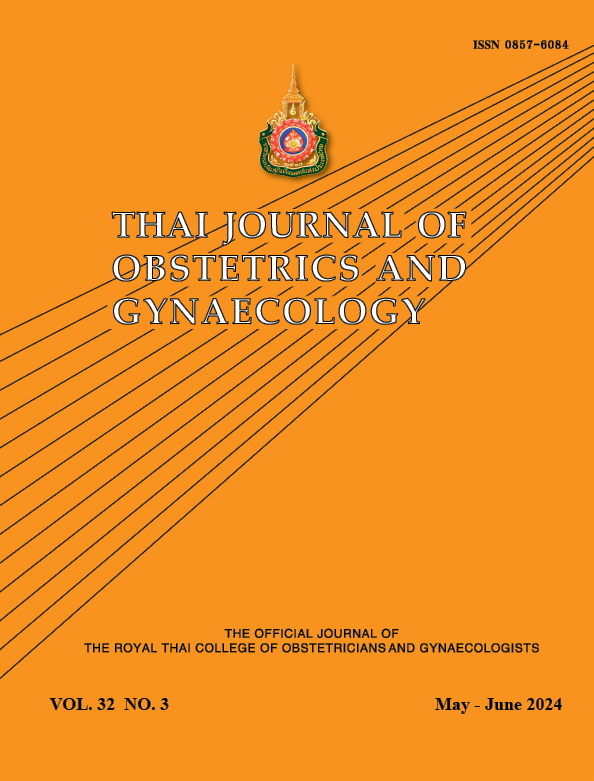Incidence, Risk factors, Maternal and Neonatal Outcomes of Second-stage Cesarean Section at Siriraj Hospital
Main Article Content
Abstract
Objectives: To determine the incidence of cesarean section (CS) during second stage of labor, to evaluate maternal and neonatal outcomes, and to determine risk factors.
Materials and Methods: A retrospective cohort study was conducted in 636 women with term, singleton pregnancies with cephalic presentation who delivered during January to April 2021. Data were extracted from medical records, including baseline, antenatal care data, mode of deliveries and outcomes. Incidence of 2nd stage CS was estimated. Maternal and neonatal outcomes were compared between different mode of deliveries.
Results: Overall CS rate was 28.5% with 22.3% occurred during 1st and 5.7% had CS during 2nd stage of labor. CS during 2nd stage of labor contributed to 19.9% of all CS. Instrumental vaginal delivery was performed in only 5.5%. Those with 2nd stage CS were more likely to be overweight or obese, and to have gestational weight gain above recommendation. The most common indications for CS was cephalopelvic disproportion. Neonatal birth weight and rate of macrosomia were significantly higher among those with 2nd stage CS while birth asphyxia was more common among 1st stage CS. Other maternal and neonatal outcomes were comparable.
Conclusion: CS during second stage of labor occurred in 5.7% of all women, contribution to 19.9% of all CS. Those with 2nd stage CS were more likely to be overweight and obese, have excessive gestational weight gain, and to have higher neonatal birth weight and rate of macrosomia. There was no increase in serious adverse outcomes in women with 2nd stage CS.
Article Details

This work is licensed under a Creative Commons Attribution-NonCommercial-NoDerivatives 4.0 International License.
References
Betran AP, Torloni MR, Zhang JJ, Gulmezoglu AM, WHO working group on caesarean section. WHO statement on caesarean section rates. BJOG 2016;123:667-70.
Betran AP, Ye J, Moller AB, Zhang J, Gulmezoglu AM, Torloni MR. The increasing trend in caesarean section rates: global, regional and national estimates: 1990-2014. PLoS One 2016;11:e0148343.
Loudon JA, Groom KM, Hinkson L, Harrington D, Paterson-Brown S. Changing trends in operative delivery performed at full dilatation over a 10-year period. J Obstet Gynaecol 2010;30:370-5.
Pearson GA, MacKenzie IZ. A cross-sectional study exploring the incidence of and indications for second-stage cesarean delivery over three decades. Int J Gynaecol Obstet 2017;138:340-6.
Vousden N, Cargill Z, Briley A, Tydeman G, Shennan AH. Caesarean section at full dilatation: incidence, impact and current management. Obstet Gynaecol 2014;16:199-205.
Radha P, Tagore S, Rahman MF, Tee J. Maternal and perinatal morbidity after caesarean delivery at full cervical dilatation. Singapore Med J 2012;53:655-8.
Davis G, Fleming T, Ford K, Mouawad MR, Ludlow J. Caesarean section at full cervical dilatation. Aust N Z J Obstet Gynaecol 2015;55:565-71.
Olah KS. Reversal of the decision for caesarean section in the second stage of labour on the basis of consultant vaginal assessment. J Obstet Gynaecol 2005;25:115-6.
Lewis EA, Barr C, Thomas K. The mode of delivery in women taken to theatre at full dilatation: does consultant presence make a difference? J Obstet Gynaecol 2011;31:229-31.
Unterscheider J, McMenamin M, Cullinane F. Rising rates of caesarean deliveries at full cervical dilatation: a concerning trend. Eur J Obstet Gynecol Reprod Biol 2011;157:141-4.
Corry EMA, Ramphul M, Rowan AM, Segurado R, Mahony RM, Keane DP. Exploring full cervical dilatation caesarean sections-A retrospective cohort study. Eur J Obstet Gynecol Reprod Biol 2018;224:188-91.
Goswami KD, Parmar MM, Kunjadiya AN. Study of fetomaternal outcome in second stage caesarean section. Int J Reprod Contracept Obstet Gynecol 2019;8:3.
Malik N, Gupta AK, Dahiya D, Nanda S, Singhal S, Perumal V. Caesarean delivery in the second stage: incidence, effect, and how to address rising rates. J Gynecol Surg 2021;37:10-15.
Allen VM, O’Connell CM, Baskett TF. Maternal and perinatal morbidity of caesarean delivery at full cervical dilatation compared with caesarean delivery in the first stage of labour. BJOG 2005;112:986-90.
Murphy DJ, Liebling RE, Verity L, Swingler R, Patel R. Early maternal and neonatal morbidity associated with operative delivery in second stage of labour: a cohort study. Lancet 2001;358:1203-7.
Rasmussen KM, Yaktine AL, editors. Weight gain during pregnancy: Reexamining the guidelines. Washington, DC: The National Academies Press; 2009.
Su L, Zhang Y, Chen C, Lu L, Sutton D, D’Alton M, Kahe K. Gestational weight gain and mode of delivery by the class of obesity: A meta-analysis. Obes Rev 2022;23:e13509.
Mustafa HJ, Seif K, Javinani A, Aghajani F, Orlinsky R, Alvarez MV, et al. Gestational weight gain below instead of within the guidelines per class of maternal obesity: a systematic review and meta-analysis of obstetrical and neonatal outcomes. Am J Obstet Gynecol MFM 2022;4:100682.
Eze P, Lawani LO, Chikezie RU, Ukaegbe CI, Iyoke CA. Perinatal outcomes of babies delivered by second-stage caesarean section versus vacuum extraction in a resource-poor setting, Nigeria - a retrospective analysis. BMC Pregnancy Childbirth 2020;20:298.


